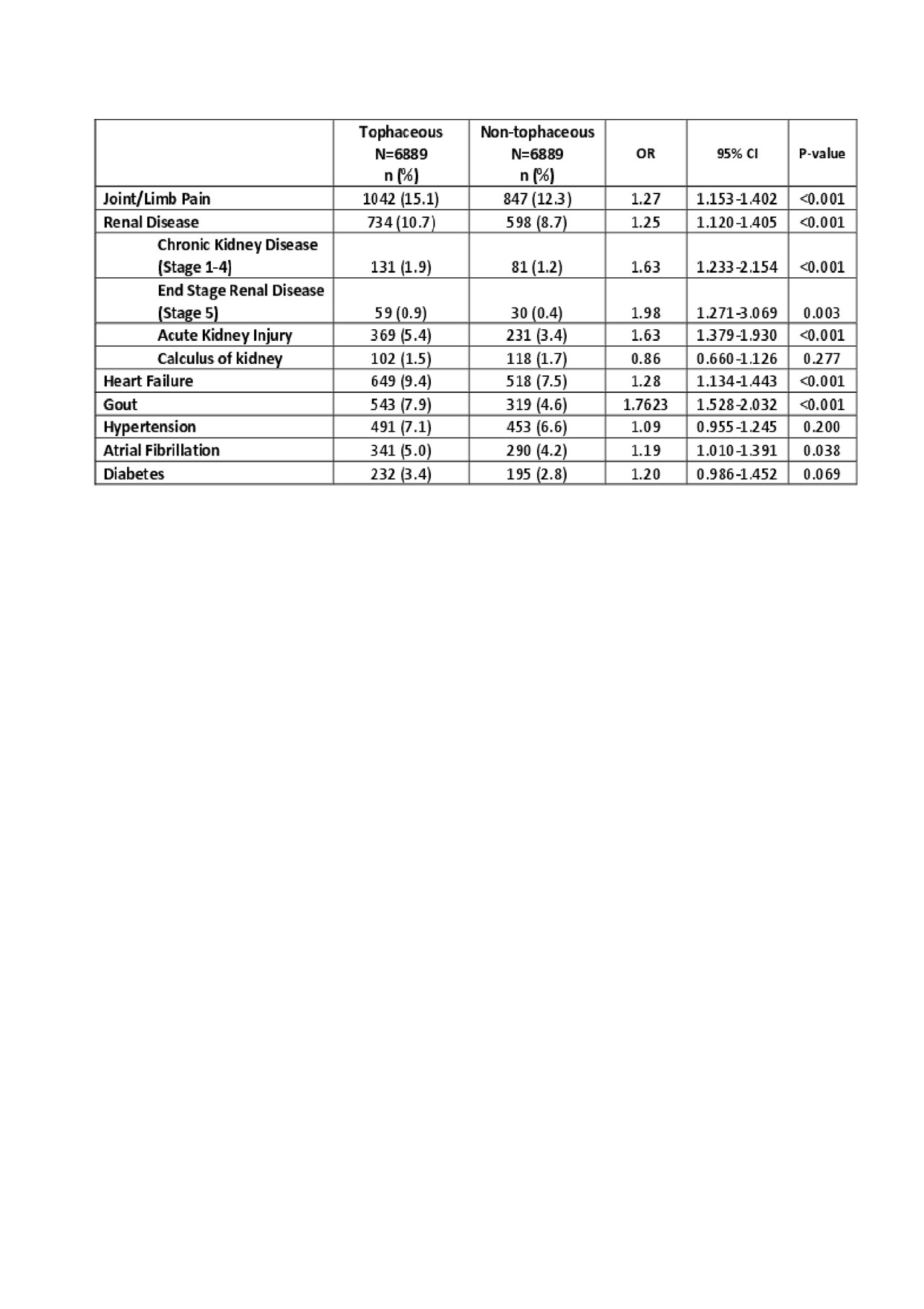Session Information
Session Type: Poster Session (Sunday)
Session Time: 9:00AM-11:00AM
Background/Purpose: From 2006 to 2012, gout was the primary indication for ~0.2% of all emergency department visits for adults, as reported in the Nationwide Emergency Department Sample (NEDS).1 The rate of emergency department visits for gout in the NEDS increased by 14% between 2006 and 2012 rising from 75.0 to 85.4 per 100,000 US adults.1 A cross-sectional study of 296 gout patients reported that a composite gout severity score, composed of mean serum uric acid, patient-rated and physician-rated gout severity, was a significant predictor of emergency/urgent care service utilization for gout treatment.2 The relationship between the presence or absence of tophi, visible monosodium urate crystal masses representing an uncontrolled stage of gout,3 and emergency department utilization has not been previously reported. The objectives of this study were to analyze the utilization of emergency department services and compare the diagnostic codes present among tophaceous and non-tophaceous gout patients.
Methods: A retrospective review of Humana Research Database data from 2007 to 2017 in private pay and Medicare patients was performed to identify patients with at least 1 gout ICD-9 diagnosis code and enrolled in the plan for at least 6 months (N=370,484). Patients were divided by gout codes into patients with at least one tophi code (tophaceous group) and patients without any tophi codes (non-tophaceous group). To decrease bias non-tophaceous patients were matched to tophaceous patients based on age, gender and race. Relevant comorbidity codes were grouped and examined. Occurrence of ICD codes during emergency department encounters were analyzed in the two groups.
Results: The tophaceous and non-tophaceous group included 6,889 patients each. The patients were mean age 70.7 years, 69.4% male, and 71.7% white. Patients in the tophaceous group had a shorter time in plan since gout diagnosis (average of 3.3 years) compared to non-tophaceous patients (average 3.7 years in plan). During the time in plan analyzed, more patients with tophaceous gout had at least one emergency department encounter than patients without tophi (71.2% tophaceous vs. 67.4% non-tophaceous; OR 1.19, 95%CI of 1.109 to 1.282, p< 0.001). On average, during this period, patients with tophi had 4.01 visits to the emergency department and the patients without tophi had 3.51.The percentage of patients with renal and cardiovascular comorbid emergency department codes were increased in the tophaceous group. Table 1 compares the percentage of patients with and without tophi with emergency department codes.
Conclusion: In this large matched database study more patients with visibly tophaceous gout had at least one emergency department encounter during the time in plan analyzed as compared with their non-tophaceous gout counterparts. Additionally, patients with tophi had a greater number of emergency department encounters in this time period. In these encounters renal and cardiovascular complications were increased in the tophaceous group.

Table 1. ICD- Codes during an Emergency Department Encounter
To cite this abstract in AMA style:
Mezgebe M, Francis-Sedlak M, LaMoreaux B, Holt R. Emergency Department Encounters in a Large US Payer Database: Tophaceous versus Non-tophaceous Gout Patients [abstract]. Arthritis Rheumatol. 2019; 71 (suppl 10). https://acrabstracts.org/abstract/emergency-department-encounters-in-a-large-us-payer-database-tophaceous-versus-non-tophaceous-gout-patients/. Accessed .« Back to 2019 ACR/ARP Annual Meeting
ACR Meeting Abstracts - https://acrabstracts.org/abstract/emergency-department-encounters-in-a-large-us-payer-database-tophaceous-versus-non-tophaceous-gout-patients/
